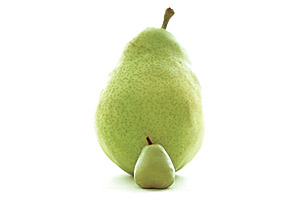
(3 of 4)
Hogs and chickens present fewer problems than cattle — at least in terms of chemicals — since government regulations prohibit farmers from using growth hormones on either animal. But antibiotics are still served up liberally, and that creates other dangers. Methicillin-resistant Staphylococcus aureus (MRSA), for example, an often deadly pathogen associated mostly with hospital-acquired infections, has been increasingly turning up in hog farmers, who contract it from their animals. In one study last year, a University of Iowa epidemiologist found that 49% of the hogs she tested were positive for MRSA, as were 45% of the humans who handled them.
Far more troubling — if only because the problem is far more widespread — is the recent recall of more than half a billion eggs from two producers due to salmonella contamination. Salmonella is hardly unheard of even among chickens raised in comfortable, free-range conditions. But when you confine half a dozen birds at a time in cages no larger than an opened broadsheet newspaper, and stack hundreds or thousands of those so-called battery cages together, you're going to spread the bacterium a lot faster. The egg manufacturers stress that thoroughly cooking eggs can kill salmonella — which is true as far as it goes. But treating chickens like conscious creatures instead of egg-manufacturing machinery can help avoid outbreaks in the first place.
Short of swearing off eggs and meat — a perfectly good choice, but with only 3% of Americans describing themselves as vegetarians, not likely for most people — there are no easy solutions. For one thing, if we all decided to switch to healthier, chemical-free meat, there wouldn't be remotely enough to go around. Only 3% of cattle in the U.S. are organically raised, and just 0.02% of hogs and 1.5% of poultry. What's more, that scarcity helps drive the already premium price higher still.
Another alternative is to eat more fish, which is healthier anyway because it's leaner, lower in calories and higher in omega-3s. But with fish stocks collapsing worldwide because of rampant overconsumption, there's only so far that solution could take us. A half measure — but a very powerful one — is simply to cut back on whatever meat we do eat, even if we can't quit it altogether. This shouldn't be too hard: Americans already consume at least 1.5 times as much meat as the USDA recommends in its famed food pyramid. And with plenty of protein to be found in eggs, soy, cheese, grains, nuts, legumes and leafy green vegetables, there is no shortage of ways to compensate.
"You need to eat animals only to close the nutrient cycle," says Fred Kirschenmann, a distinguished fellow at the Leopold Center for Sustainable Agriculture at Iowa State University. "If we changed a few things about how we live, we'd have fewer animals in the system."
Cash Crops
When animal protein, whether organic or not, becomes a supporting player in the diet, then fruits, veggies and grains take the lead. That's generally a good thing, but here too there are complications. The back-to-the-land ideal of farming without the use of synthetic pesticides and other chemicals can take you only so far in a country with 309 million mouths to feed (not to mention a world with 6.8 billion). Say what you will about the environmental depredations of agribusiness, industrial farms coax up to twice as much food out of every acre of land as organic farms do. And even that full-tilt output may not be enough to keep up with a global population that's galloping ahead to a projected 9 billion by 2050.
"Only about 5% of the arable land on the planet remains unused," says McWilliams. "But we'll need to increase food production by 50% to 100%." If we have to spray, fertilize and even genetically engineer our way there, that's something we may simply have to accept.
In the U.S., running out of crop foods is not a problem — at least not yet — but pesticide residues on fruits and vegetables cause people some perfectly reasonable worries. Properly washing or peeling produce can take care of most of the problem, but if you buy organic, you avoid the pesticide issue altogether, right? Not necessarily. It's not just that drift from nearby nonorganic farms can contaminate other crops in the vicinity; it's also that organic farmers use pesticides of their own. According to the Environmental Protection Agency, there are now 195 registered biopesticides — substances derived from animals, plants or minerals that are toxic to certain species — used in 780 commercial products. There is broad agreement that biopesticides are not as dangerous as commercial pesticides, but less toxic doesn't mean nontoxic, and even such lower-impact chemistry has a nasty habit of hanging around in soil and water longer than you want it to. "Organic farming may represent only 2% of the total of all farming," says McWilliams, "but what if it became 20%? The chemicals are used only sparingly now, but they wouldn't be then."
Organic fertilizers are less of a problem, since they consist mostly of manure, as well as other relatively benign materials like peat, seaweed, saltpeter and compost. Humble as such substances are, however, they can become awfully pricey, because you need very big quantities to pack the same fertilizing punch as synthetic brands do. "It can take four tons of manure per acre to raise food," says McWilliams. "When you know that, a bag of synthetic fertilizer starts to look pretty good."